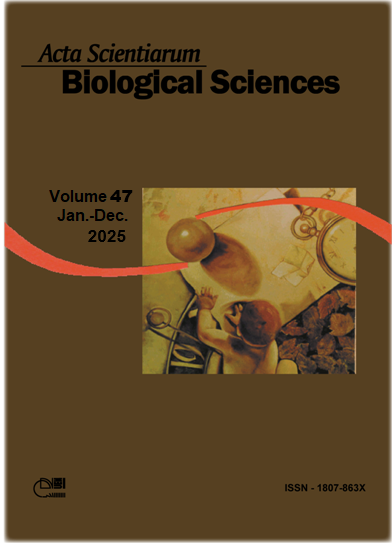Evaluation of scarification and in vitro culture methods for callus production in the genus Erythrina
Resumo
The genus Erythrina (Fabaceae) has been researched due to its tetracyclic alkaloids that have pharmacological properties. Species of Erythrina have the potential to act on the central nervous system, presenting anxiolytic and anticonvulsant properties. Among them, Erythrina verna is particularly known for its anxiolytic and sedative effects, being widely used in traditional medicine. Studies indicate that the species E. speciosa has gastroprotective properties besides its high ornamental value. In vitro culture involves techniques for growing cells, tissues or organs under aseptic conditions, based on culture media containing essential nutrients for development. In addition, different seed scarification techniques and aseptic methods can be employed to achieve better results, which may vary for each species. In this context, the present work aimed to standardize the methodology of ‘callus culture’ in two species of Erythrina, as well as to evaluate the behavior of these plants under in vitro conditions. The methodology employed for in vitro germination of Erythrina verna and E. speciosa seeds was successful, resulting in seedlings with well-developed stem, cotyledons and root, which served as a source of explants for ‘callus culture’. The scarification techniques used were effective in breaking dormancy in both species. Additionally, the sterilization, disinfection, and cleaning processes played a crucial role in the satisfactory in vitro development of the species.
Downloads
Referências
Amaral, P. A., Antunes, A. R., & Barlow, J. W. (2019). Isolation of erythrinan alkaloids from the leaves and flowers of Erythrina speciosa. Revista Brasileira de Farmacognosia, 29(4), 488-490. https://doi.org/10.1016/j.bjp.2019.01.007
Bewley, J. D., & Black, M. (2013). Seeds: physiology of development and germination. Springer Science & Business Media.
Ferreira, D. F. (2019). Sisvar: A guide for its bootstrap procedures in multiple comparisons. Ciência e Agrotecnologia, 43, e004201. https://doi.org/10.1590/1413-7054201943004201
Ferreira, E. G. B. S., Matos, V. P., Silva, R. B., Santos, H. H. D., & Sena, L. H. M. (2014). Thermal scarification to overcome Piptadenia moniliformis seeds dormancy. Revista Brasileira de Ciências Agrárias, 9(1), 79-83.
Fidemann, T., de Araujo Pereira, G. A., Bossard Nascimento, L., Moraes, M. C., Bertão, M. R., da Silva, R. M. G., & Fernández Núñez, E. G. (2017). Holistic protocol for callus culture optimization using statistical modelling. Natural Product Research, 32(9), 1109–1117. https://doi.org/10.1080/14786419.2017.1380026
García-Mateos, R., Soto-Hernández, M., Martínez-Vázquez, M., & Villegas-Monter, A. (1999). Isolation of alkaloids of Erythrina from tissue culture. Phytochemical Analysis, 10(1), 12-16. https://doi.org/10.1002/(SICI)1099-1565(199901/02)10:1<12::AID-PCA425>3.0.CO;2-A
Lloyd, G., & McCown, B. H. (1980). Commercially feasible micropropagation of mountain laurel (Kalmia latifolia) by use of shoot-tip culture. Combined Proceedings of the International Plant Propagator’s Society, 30, 421–427.
Lorenzi, H., Souza, H. M., Torres, M. A. V., & Bacher, L. B. (2003). Árvores exóticas no Brasil: Madeiras, ornamentais e aromáticas. Instituto Plantarum.
Magalhães, C. R., Garcia, Q. S., & Oliveira, D. M. T. (2021). Post-dispersion humidity condition alters the surface of the testa and the proportion of seeds with physical dormancy in Erythrina speciosa. Seed Science Research, 31(2), 149-156. https://doi.org/10.1017/S0960258520000495
Moreira, J. F., Cunha, A. L., Costa, J. P., & Sousa, L. A. (2017). Avaliação de métodos de quebra de dormência em sementes de Annona muricata L. Revista GeTeC, 6(14), 118-127.
Oliveira Prudente, D., Carlota Nery, F., Paiva, R., Valquíria dos Reis, M., Duarte de Oliveira Paiva, P., & Carlota Nery, M. (2016). Cultivo in vitro de Miconia ligustroides (DC.) Naudin. Plant Cell Culture & Micropropagation, 12(1), 13–19. http://pccm.ufla.br/index.php/plantcellculturemicropropagation/article/view/83
Pereira, A. M. S., Souza, V. T. A., Coppede, J. S., França, S. C., Bertoni, B. W., & Souza, A. V. V. (2014). Seed germination and production of Erythrina mulungu and Erythrina velutina plantlets. American Journal of Plant Sciences, 5(5), 535-540. https://doi.org/10.4236/ajps.2014.55068
Rambo, D. F., Biegelmeyer, R., Toson, N. S. B., Dresch, R. R., Moreno, P. R. H., & Henriques, A. T. (2019). The genus Erythrina L.: a review on its alkaloids, preclinical, and clinical studies. Phytotherapy Research, 33(5), 1258-1276. https://doi.org/10.1002/ptr.6321
Silva, K. B., Reiniger, L. R. S., Rabaiolli, S. M. S., Stefanel, C. M., & Silva, L. D. (2019). Rizogênese in vitro em brotações de Luehea divaricata Mart. & Zucc. Ciência Florestal, 29(3), 1282-1295. https://doi.org/10.5902/1980509826045
DECLARAÇÃO DE ORIGINALIDADE E DIREITOS AUTORAIS
Declaro que o presente artigo é original, não tendo sido submetido à publicação em qualquer outro periódico nacional ou internacional, quer seja em parte ou em sua totalidade.
Os direitos autorais pertencem exclusivamente aos autores. Os direitos de licenciamento utilizados pelo periódico é a licença Creative Commons Attribution 4.0 (CC BY 4.0): são permitidos o compartilhamento (cópia e distribuição do material em qualqer meio ou formato) e adaptação (remix, transformação e criação de material a partir do conteúdo assim licenciado para quaisquer fins, inclusive comerciais.
Recomenda-se a leitura desse link para maiores informações sobre o tema: fornecimento de créditos e referências de forma correta, entre outros detalhes cruciais para uso adequado do material licenciado.












1.png)




3.png)













